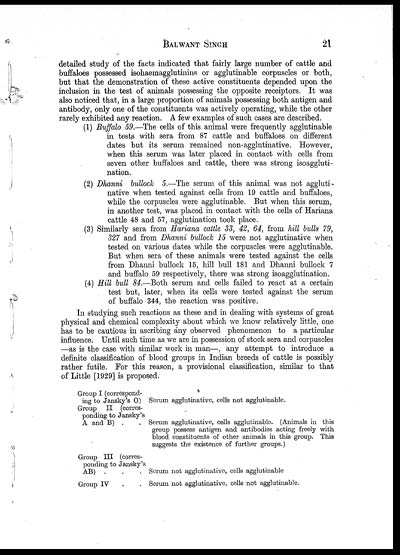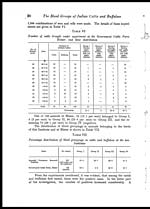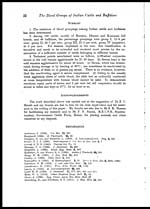Medicine - Veterinary > Veterinary colleges and laboratories > Indian journal of veterinary science and animal husbandry > Volume 12, 1942 > Original articles > Blood groups of Indian cattle and buffaloes
(27) Page 21
Download files
Individual page:
Thumbnail gallery: Grid view | List view

BALWANT SINGH 21
detailed study of the facts indicated that fairly large number of cattle and
buffaloes possessed isohaemagglutinins or agglutinable corpuscles or both,
but that the demonstration of these active constituents depended upon the
inclusion in the test of animals possessing the opposite receiptors. It was
also noticed that, in a large proportion of animals possessing both antigen and
antibody, only one of the constituents was actively operating, while the other
rarely exhibited any reaction. A few examples of such cases are described.
(1) Buffalo 59.—The cells of this animal were frequently agglutinable
in tests with sera from 87 cattle and buffaloes on different
dates but its serum remained non-agglutinative. However,
when this serum was later placed in contact with cells from
seven other buffaloes and cattle, there was strong isoaggluti-
nation.
(2) Dhanni bullock 5.—The serum of this animal was not aggluti-
native when tested against cells from 19 cattle and buffaloes,
while the corpuscles were agglutinable. But when this serum,
in another test, was placed in contact with the cells of Hariana
cattle 48 and 57, agglutination took place.
(3) Similarly sera from Hariana cattle 33, 42, 64, from hill bulls 79,
327 and from Dhanni bullock 15 were not agglutinative when
tested on various dates while the corpuscles were agglutinable.
But when sera of these animals were tested against the cells
from Dhanni bullock 15, hill bull 181 and Dhanni bullock 7
and buffalo 59 respectively, there was strong isoagglutination.
(4) Hill bull 84.—Both serum and cells failed to react at a certain
test but, later, when its cells were tested against the serum
of buffalo 344, the reaction was positive.
In studying such reactions as these and in dealing with systems of great
physical and chemical complexity about which we know relatively little, one
has to be cautious in ascribing any observed phenomenon to a particular
influence. Until such time as we are in possession of stock sera and corpuscles
—as is the case with similar work in man—, any attempt to introduce a
definite classification of blood groups in Indian breeds of cattle is possibly
rather futile. For this reason, a provisional classification, similar to that
of Little [1929] is proposed.
|
Group I (correspond- |
Serum agglutinative, cells not agglutinable. |
|
Group II (corres- |
Serum agglutinative, cells agglutinable. (Animals in this |
|
Group III (corres- |
Serum not agglutinative, cells agglutinable |
|
Group IV . . |
Serum not agglutinative, cells not agglutinable. |
Set display mode to: Large image | Zoom image | Transcription
Images and transcriptions on this page, including medium image downloads, may be used under the Creative Commons Attribution 4.0 International Licence unless otherwise stated. ![]()
| Permanent URL | https://digital.nls.uk/75259166 |
|---|
| Description | Covers articles from 1942. |
|---|




